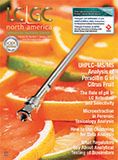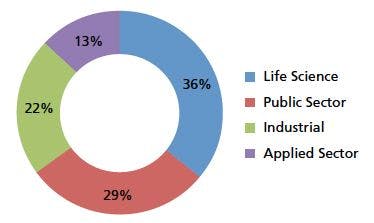Three Common SPE Problems
LCGC North America
Tips and tricks to help you recognize and solve the most common SPE problems.
Three of the most common problems seen with solid-phase extraction (SPE) are poor recovery, reproducibility issues, and sample extracts being insufficiently clean.
The first step in troubleshooting recovery or irreproducibility problems is to verify that the analytical system is functioning correctly. Reproducibility problems can be caused by sample carryover, detector problems, or a defective autosampler. Injection of known standards in the final extract solvent will verify that the response factor of the analytical instrument has not changed. Repeated injections of pure standards can verify injection reproducibility, and injection of standards of wide-ranging concentration (very high levels followed by very low levels) can diagnose carryover.
Next, each step of the SPE protocol must be assessed to confirm if, and where, analytes are being lost, resulting in poor recovery. This assessment is done by processing standards through the extraction procedure, collecting fractions from each protocol step, and analyzing them to determine where the analytes are being lost. If breakthrough is occurring during sample loading or wash steps, check that the solvents being used are correct in these steps and any conditioning or pre-equilibration steps because these influence retention. Try altering the sample solvent or the wash steps to enhance retention for the sorbent mechanism. If the analytes are being retained on the column but are not being eluted, verify that the solvent is correct, and then increase the solvent elution strength. Also, review the possibility of analyte–sorbent secondary interactions and confirm that the elution solvent addresses these. Finally, it may be necessary to change to a less retentive sorbent.
If the SPE protocol is working correctly it is likely that the analytes are never reaching the column during the loading step or are breaking through during loading but are not detectable in the fraction. The former problem may be caused by analyte instability in the sample; also, if the sample pretreatment involves protein precipitation and the analytes are protein bound they may be precipitating with the protein fraction.
Alternatively, the protein-bound analytes may be passing through the SPE column unretained and are undetectable via the analytical procedure in their bound condition. When liquid chromatography–mass spectrometry (LC–MS) is being used, the matrix can cause suppression or enhancement of the analyte signal. If the interferences are not suitably removed by SPE, pretreatment steps may be required, such as liquid–liquid extraction to remove oils, fats or lipids; ion exchange, desalting, or use of a nonpolar sorbent to remove inorganic salts; and pH modification, ultrafiltration, or precipitation to remove proteins that can bind to analytes.
In the case of poor or inconsistent recoveries, it is also always worth looking at the sorbent itself and comparing lot numbers of the sorbent exhibiting poor results with the lot numbers of the original sorbents used.
Symptoms of a sample that needs further cleanup are poor reproducibility, column failure (high back pressure or changing retention times), and incorrect quantitation. To resolve this problem, either modify the wash protocols, use another sorbent that provides the same extraction mechanism as the original sorbent, or change the extraction method completely.
The wash solvent should have the strongest elution strength for the mechanism employed so that it elutes the maximum number of interferences but not the analyte.
The wash step can also be improved by using a solvent in which the analyte is insoluble-for example, in a nonpolar extraction water-miscible solvents that are weaker than the elution solvent are normally employed-however, dramatic improvements in cleanliness may be achieved by using very nonpolar water-immiscible solvents such as dichloromethane, ethyl acetate, or hexane.
These solvents exhibit very strong elution characteristics for the nonpolar mechanism (for example, they will elute many interferences), yet analyte insolubility means that it will be retained on the sorbent surface. The elution solvent can also be manipulated; a weaker solvent may result in cleaner extracts, but analyte recovery should be monitored. If altering wash solvents does not provide sufficient additional cleanup, changing the sorbent may help.
For example, if the method uses a C8 sorbent, a less retentive C4 or C2 sorbent may be employed because these sorbents tend to retain fewer matrix components. However, ensure that your analyte is sufficiently retained on the less retentive phase.
The final step to improve sample cleanliness is to change the extraction mechanism entirely. Appropriate alternatives may be identified by reviewing the information gained during method development regarding potential usable mechanisms.
One especially effective technique is to move from a single extraction mechanism to a mixed-mode mechanism. This approach works best for analytes that contain both nonpolar and ionizable functional groups.

Common Challenges in Nitrosamine Analysis: An LCGC International Peer Exchange
April 15th 2025A recent roundtable discussion featuring Aloka Srinivasan of Raaha, Mayank Bhanti of the United States Pharmacopeia (USP), and Amber Burch of Purisys discussed the challenges surrounding nitrosamine analysis in pharmaceuticals.
Extracting Estrogenic Hormones Using Rotating Disk and Modified Clays
April 14th 2025University of Caldas and University of Chile researchers extracted estrogenic hormones from wastewater samples using rotating disk sorption extraction. After extraction, the concentrated analytes were measured using liquid chromatography coupled with photodiode array detection (HPLC-PDA).













